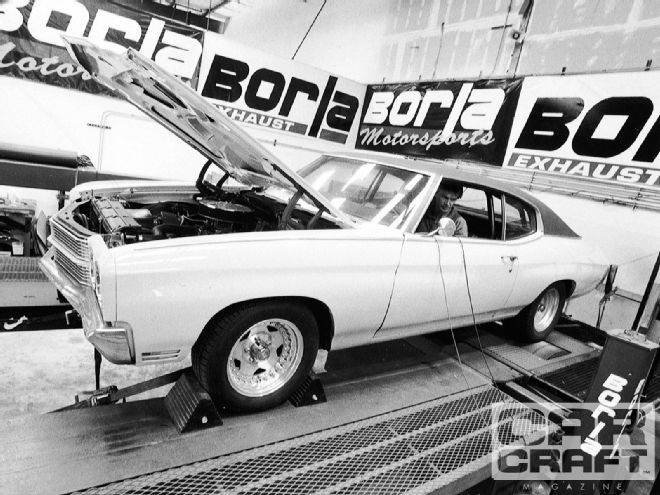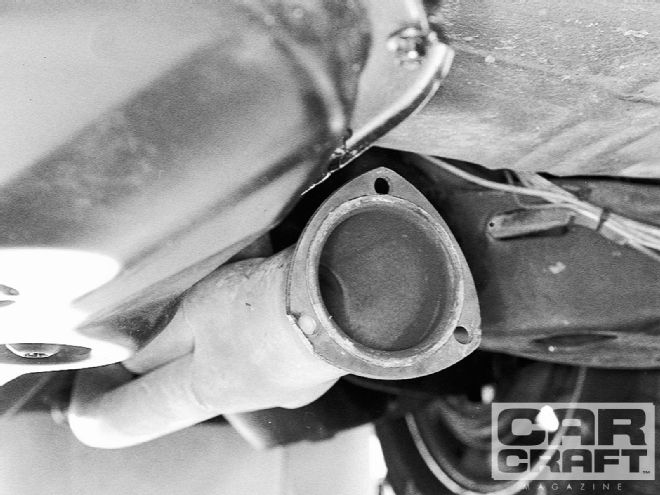
You asked for it! Based on the vote results from CC's May '98 "Design Your Own Issue Of Car Craft," lots of readers wanted to see an exhaust size comparison. Specifically, if there really was any horsepower difference between 2 1/4 exhaust vs 3 exhaust on a typical street car. Ask and you shall receive.
Rather than pit different companies against each other in our exhaust size comparison (or compare mix-n'-matched parts), we called around to find a company that offered (via mail-order) both 2 1/4- and 3-inch exhaust systems for the same car. We found that Borla Performance offers a 2 1/4-inch exhaust system for a GM A-body (Malibu/Chevelle, Cutlass/442, Skylark/GS, and LeMans/GTO) and was in the midst of finishing up its all-new 3-inch system for GM A-bodies. We cruised the Cheap Street Chevelle to Borla for some exhaust size comparison research and dyno flogging.
The '70 Chevelle mimics what many readers own. The engine is a low-buck, rebuilt 355-inch small-block that uses traditional mail-order hop-up parts (9.9:1 compression, a Comp Cams 275DEH cam, an Edelbrock Performer intake, a rebuilt Q-jet carb, an HEI, and headers). On the dyno the 355 delivered 355.6 hp and 386.2 lbs-ft of torque-a pretty average combo all-in-all. However, average may have been too weak to clearly differentiate what size exhaust system is really better. If we'd had a more burly engine (such as a big-block, or if we ran the tests with nitrous or a blower) the differentiation between the smaller and larger exhaust systems would likely become more apparent. But we're not here to speculate, we're here to separate fact from myth using a traditional street machine not an 8- or 9-second "street car."
Exhaust Size Comparison
Chassis Dyno
Note: Dyno tests measure rear wheel horsepower
not flywheel horsepower.
Open Headers
Borla 2 1/2-inch
Borla 3-inch
RPM
HP
Torque
HP
Torque
HP
Torque
4500
213.3
248.9
211.5
246.9
209.1
244.1
4600
236.2
269.7
236.2
269.7
236.0
269.5
4700
239.6
267.7
240.7
268.9
239.0
267.1
4800
239.2
261.7
242.1
264.9
243.1
266.0
4900
237.5
254.5
242.8
260.3
242.9
260.3
5000
238.6
250.6
240.3
252.4
242.1
254.4
5100
236.4
243.4
240.1
247.3
239.4
246.6
5200
235.1
237.4
238.3
240.7
239.4
241.8
5300
235.6
233.5
238.1
235.9
238.8
236.6
5400
231.3
225.0
234.2
227.8
240.3
233.7
5500
229.5
219.1
231.8
221.3
233.4
222.9
5600
226.1
212.1
231.8
217.4
231.4
217.0
5700
222.6
205.1
224.6
206.9
227.9
210.0
5800
214.6
194.3
222.7
201.6
222.6
210.6
5900
213.3
189.9
216.7
192.9
218.1
194.2
6000
216.9
203.9
207.9
189.9
214.1
187.4
Average
229.9
234.2
230.4
230.8
231.3
231.6
Noise Level Inside Car Open Headers Borla 2 1/4-inch Borla 3-inch RPM dB RPM dB RPM dB 2000 96 2000 80 2000 82 4000 104 4000 91 4000 92 6000 115 6000 95 6000 96
Borla says:
"There is no easy answer, but as a basic rule, if the car is used for your daily driver, and/or if it has a fairly stock engine, you'll be happier with a smaller (such as 2 1/4-inch) system. The performance you'd gain with the larger system usually isn't worth the loss of better sound quality. However, if the engine is very built-up, and if you race it on the weekends, you may want to reap the benefits of the larger and louder 3-inch system."
Flowmaster says:
"This is the age old question: Power or sound control? Flowmaster doesn't recommend 3-inch for street use because of the sound legality side of things. Basically, a 400hp engine is quite happy with 2 1/2-inch exhaust. It doesn't matter if it's blown or nitrous fed as long as it doesn't make over 400 hp. If you're going to be much over this in the way of power (i.e. if your base engine is 350 hp, but the bottle drives it up to 500 hp), you will likely need 3-inch duals. The bottom line on power enhancers is, how much of the time will it be run in this mode? If it's very limited use, stick with 2 1/2-inch and enjoy the sound.
As for engine size versus exhaust size, the engine is an air pump. If a 350 engine produces 400 hp at 6,000 rpm, it has "X" air and exhaust flow. A 454 engine producing the same 400 hp at a power peak of 5,200 will be flowing the same air and exhaust flow (within a few percent). Therefore, the exhaust flow requirements between the two engines are the same even though the 454 is a larger cube engine."
DynoMax says:
"A common misconception is that the larger the diameter the better the system. But, bigger isn't always better. Systems that are too large in diameter can actually hurt performance. As a general rule (when not running a high compression ratio, nitrous, and/or a blower), switching to a performance exhaust system that is 1/4- to 1/2-inch larger than stock will provide you with the best horsepower increase. To determine which pipe diameter will be best for your system, decide what rpm range your engine will operate at most of the time. Smaller diameter pipes will usually produce better low- to mid-rpm torque. Larger diameter pipes usually produce more mid- to high-rpm torque."

Step one involved jerking off the Chevelle's cobbled-together dual exhaust system and running open-headered on the chassis dyno. During testing, the Chevelle sounded full race but quickly began to annoy everybody within a 400-mile radius.